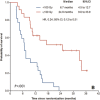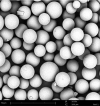Beyond the MAA-Y90 Paradigm: The Evolution of Radioembolization Dosimetry Approaches and Scout Particles
- PMID: 34853500
- PMCID: PMC8612836
- DOI: 10.1055/s-0041-1736660
Beyond the MAA-Y90 Paradigm: The Evolution of Radioembolization Dosimetry Approaches and Scout Particles
Abstract
Radioembolization is a well-established treatment for primary and metastatic liver cancer. There is increasing interest in personalized treatment planning supported by dosimetry, as it provides an opportunity to optimize dose delivery to tumor and minimize nontarget deposition, which demonstrably increases the efficacy and safety of this therapy. However, the optimal dosimetry procedure in the radioembolization setting is still evolving; existing data are limited as few trials have prospectively tailored dose based on personalized planning and predominantly semi-empirical methods are used for dose calculation. Since the pretreatment or "scout" procedure forms the basis of dosimetry calculations, an accurate and reliable technique is essential. 99m Tc-MAA SPECT constitutes the current accepted standard for pretreatment imaging; however, inconsistent patterns in published data raise the question whether this is the optimal agent. Alternative particles are now being introduced to the market, and early indications suggest use of an identical scout and treatment particle may be superior to the current standard. This review will undertake an evaluation of the increasingly refined dosimetric methods driving radioembolization practices, and a horizon scanning exercise identifying alternative scout particle solutions. Together these constitute a compelling vision for future treatment planning methods that prioritize individualized care.
Keywords: Y90; novel techniques; positron emission tomography; radioembolization; single-photon emission computed tomography; technetium-MAA.
Thieme. All rights reserved.
Conflict of interest statement
Conflict of Interest None declared.
Figures








Similar articles
-
The superior predictive value of 166Ho-scout compared with 99mTc-macroaggregated albumin prior to 166Ho-microspheres radioembolization in patients with liver metastases.Eur J Nucl Med Mol Imaging. 2020 Apr;47(4):798-806. doi: 10.1007/s00259-019-04460-y. Epub 2019 Aug 9. Eur J Nucl Med Mol Imaging. 2020. PMID: 31399801 Free PMC article.
-
Planning dosimetry for 90 Y radioembolization with glass microspheres: Evaluating the fidelity of 99m Tc-MAA and partition model predictions.Med Phys. 2020 Oct;47(10):5333-5342. doi: 10.1002/mp.14452. Epub 2020 Sep 9. Med Phys. 2020. PMID: 32790882
-
Personalized predictive lung dosimetry by technetium-99m macroaggregated albumin SPECT/CT for yttrium-90 radioembolization.EJNMMI Res. 2014 Jun 29;4:33. doi: 10.1186/s13550-014-0033-7. eCollection 2014. EJNMMI Res. 2014. PMID: 25024931 Free PMC article.
-
Clinical impact of (99m)Tc-MAA SPECT/CT-based dosimetry in the radioembolization of liver malignancies with (90)Y-loaded microspheres.Eur J Nucl Med Mol Imaging. 2016 Mar;43(3):559-75. doi: 10.1007/s00259-015-3157-8. Epub 2015 Sep 4. Eur J Nucl Med Mol Imaging. 2016. PMID: 26338177 Free PMC article. Review.
-
Dosimetry of Y-90 Microspheres Utilizing Tc-99m SPECT and Y-90 PET.Semin Nucl Med. 2019 May;49(3):211-217. doi: 10.1053/j.semnuclmed.2019.01.005. Epub 2019 Jan 31. Semin Nucl Med. 2019. PMID: 30954187 Review.
Cited by
-
Transarterial Radioembolization (TARE) Global Practice Patterns: An International Survey by the Cardiovascular and Interventional Radiology Society of Europe (CIRSE).Cardiovasc Intervent Radiol. 2024 Sep;47(9):1224-1236. doi: 10.1007/s00270-024-03768-z. Epub 2024 Jun 24. Cardiovasc Intervent Radiol. 2024. PMID: 38914769 Free PMC article.
-
Dosimetric study on radioembolization with 166Ho poly L-lactic acid microspheres: dead time effects on prediction power.EJNMMI Phys. 2025 Jul 3;12(1):64. doi: 10.1186/s40658-025-00779-8. EJNMMI Phys. 2025. PMID: 40608221 Free PMC article.
-
SIRT in 2025.Cardiovasc Intervent Radiol. 2022 Nov;45(11):1622-1633. doi: 10.1007/s00270-022-03228-6. Epub 2022 Aug 8. Cardiovasc Intervent Radiol. 2022. PMID: 35941244 Free PMC article. Review.
-
Another hammer, but we need a wrench, and a screwdriver-positron emission tomography/magnetic resonance imaging represents another tool for post-delivery 90Y dosimetry, but what are we still missing?J Gastrointest Oncol. 2024 Aug 31;15(4):2006-2010. doi: 10.21037/jgo-24-460. Epub 2024 Aug 19. J Gastrointest Oncol. 2024. PMID: 39279923 Free PMC article. No abstract available.
-
Advances and Emerging Techniques in Y-90 Radioembolization for Hepatocellular Carcinoma.Cancers (Basel). 2025 Apr 29;17(9):1494. doi: 10.3390/cancers17091494. Cancers (Basel). 2025. PMID: 40361421 Free PMC article. Review.
References
-
- Roosen J, Klaassen N JM, Westlund Gotby L EL.To 1000 Gy and back again: a systematic review on dose-response evaluation in selective internal radiation therapy for primary and secondary liver cancer[published online ahead of print April 10, 2021]Eur J Nucl Med Mol Imaging 202110.1007/s00259-021-05340-0 - DOI - PMC - PubMed
-
- Salem R, Padia S A, Lam M. Clinical and dosimetric considerations for Y90: recommendations from an international multidisciplinary working group. Eur J Nucl Med Mol Imaging. 2019;46(08):1695–1704. - PubMed
-
- European Council . European Council Directive 2013/59/Euratom on basic safety standards for protection against the dangers arising from exposure to ionising radiation and repealing Directives 89/618/Euratom, 90/641/Euratom, 96/29/Euratom, 97/43/Euratom and 2003/122/Euratom. OJ EU L13. 2014;57:1–73.
-
- Kao Y H, Tan E H, Ng C E, Goh S W. Clinical implications of the body surface area method versus partition model dosimetry for yttrium-90 radioembolization using resin microspheres: a technical review. Ann Nucl Med. 2011;25(07):455–461. - PubMed

